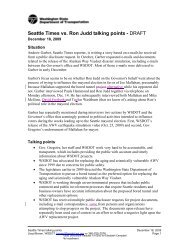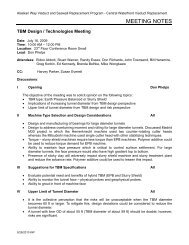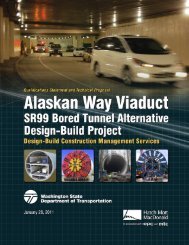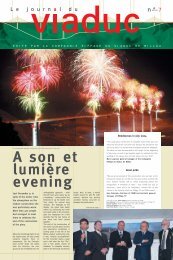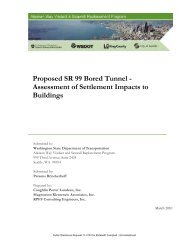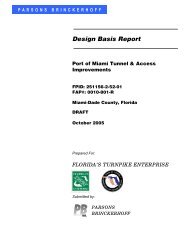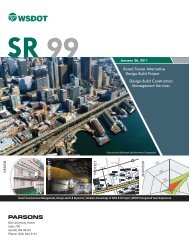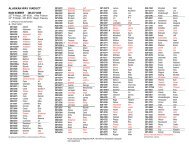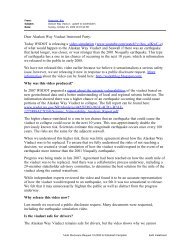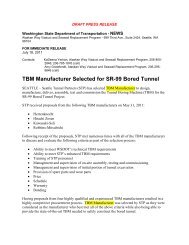herrenknecht ag softground tbms > 40 ft - SCATnow
herrenknecht ag softground tbms > 40 ft - SCATnow
herrenknecht ag softground tbms > 40 ft - SCATnow
You also want an ePaper? Increase the reach of your titles
YUMPU automatically turns print PDFs into web optimized ePapers that Google loves.
MIXSHIELDS PART 2<br />
Operating pressure during advance [bar]<br />
15.0<br />
12.5<br />
10.0<br />
7.5<br />
5.0<br />
2.5<br />
2.5<br />
Mülheim<br />
ø 6.9m<br />
sandstone,<br />
mudstone<br />
Grauholz<br />
ø 11.6m<br />
sand, gravel<br />
molasse<br />
HERA<br />
ø 5.95m<br />
sand, gravel<br />
3.5 3.5<br />
Sydney<br />
ø 10.4m<br />
sandstone, clay<br />
0.0<br />
1985 1986 1987 1988 1989 1990 1991 1992 1993 1994 1995 1996 1997 1998 1999 2000 2001 2000 2003<br />
While it is possible to accomplish the<br />
required shield thrust by changing the<br />
number or diameter of the thrust cylinders,<br />
far more sophisticated technical solutions are<br />
required for seal systems. This is especially<br />
true of the main bearing seal system, which is<br />
one of the most sensitive design elements in<br />
high-pressure applications. For support<br />
pressures beyond 4 bar, pre-stressed<br />
cascade systems are used with the individual<br />
cascade chamber pressures automatically<br />
following the face pressure.<br />
Westerschelde<br />
ø 11.34m<br />
sand, clay<br />
Wesertunnel<br />
ø 11.67m<br />
gravel, clay, boulders<br />
4. Elbröhre<br />
ø 14.2m<br />
gravel, clay, boulders<br />
Above: Fig 9 - Operating pressure of Herrenknecht Mixshields<br />
Torque main drive [kNm]<br />
<strong>40</strong>,000<br />
35,000<br />
30,000<br />
25,000<br />
20,000<br />
15,000<br />
10,000<br />
5,000<br />
0<br />
Design Mixshield [kNm]<br />
Design EPB [kNm]<br />
4.0<br />
5.5<br />
7.5<br />
Hallandsas<br />
ø 10.53m<br />
design pressure<br />
13.0<br />
Diver assignment cutting tool change<br />
Hallandsas<br />
Grauholz<br />
SMART<br />
Chongming,<br />
Nanjing<br />
4. Elbröhre<br />
2 4 6 8 10 12 14 16<br />
Shield diameter [m]<br />
H8<br />
H3/4<br />
Zürich-Thalwil<br />
Above: Fig 10 - Torque comparison of cutterhead drives (Mixshield vs EPB-shield)<br />
Below: Fig 11 - Chongming alignment<br />
Tunnel<br />
9km<br />
Elevated highway<br />
6.5km<br />
A86<br />
Bridge<br />
10km<br />
Shanghai Changxing Chongming<br />
Island<br />
These systems can handle pressures far<br />
beyond 10 bar for an extended period of<br />
time in dynamic mode without the risk of<br />
overloading the individual lip seals. Longterm<br />
field experience with large diameter<br />
drive systems (bearing diameter range of<br />
6m) with face pressures of 7 bar to 10 bar<br />
already exist and full scale workshop and<br />
commissioning test programmes with<br />
pressures of 15 bar have been performed<br />
successfully. In emergencies or extended<br />
stopp<strong>ag</strong>es (long-term static mode),<br />
additional inflatable seals are included.<br />
While it is now possible to address highpressure<br />
operations by using appropriately<br />
designed equipment, the key questions<br />
relate more to the potential and the<br />
limitations for chamber access under<br />
hyperbaric conditions.<br />
Technical solutions to reduce the need<br />
for man access to the excavation chamber<br />
are available and currently include:<br />
• Accessible cutterheads for atmospheric<br />
cutter tool change (larger machines only)<br />
• Remotely activated standby cutter tools<br />
• Load detection and wear sensor systems<br />
However, these technical features will not<br />
totally eliminate the need for a “Plan B” for<br />
manual intervention to cover unforeseen<br />
conditions or worst-case scenarios.<br />
Based on the system of excavation and<br />
face support, a Mixshield requires lower<br />
cutterhead torque compared with an EPB<br />
shield (figure 10), as the cutterhead is only<br />
excavating the ground at the tunnel face<br />
into the suspension-filled excavation<br />
chamber. The excavated soil sinks towards<br />
the submerged wall opening in the invert<br />
due to gravity, assisted by the flow direction<br />
of the circulated slurry, and is carried to the<br />
suction pipe a<strong>ft</strong>er clearing the rock crusher<br />
and suction grille.<br />
An EPB shield requires a comparatively<br />
high torque at the cutterhead because, in<br />
addition to the soil excavation, the<br />
cutterhead itself acts as a mixing tool inside<br />
the excavation chamber, which is<br />
completely filled with muck.<br />
Therefore by adopting high torque EPB<br />
drive systems that have been developed for<br />
large diameter machines, such as that used<br />
on the M30 project, in Madrid (with<br />
125,000kNm), there is huge potential for the<br />
development of larger diameter Mixshield<br />
machines.<br />
Examples of projects<br />
The following presentation of the<br />
Chongming and A86 tunnel projects<br />
demonstrates the efficiency of current<br />
Mixshields and the value of development.<br />
Mixshield used as a shield with slurry<br />
supported face – Chongming, China: A<br />
twin tube road tunnel is currently being built<br />
beneath the Yangtze River in the city of<br />
Shanghai, comprising two 7160m-long bores<br />
with three lanes each. The tunnel, along with<br />
a new bridge, will link the islands of<br />
Changxing and Chongming to the freeway<br />
system and city. The geology of the tunnel is<br />
defined by its position in the river delta,<br />
consisting of so<strong>ft</strong> clay deposits and thin sand<br />
layers. The tunnel has an outside diameter of<br />
15m. The pre-cast concrete ring consists of<br />
9+1 segments with a length of 2m. The<br />
segments are 6<strong>40</strong>mm thick and weigh up to<br />
16.7 tons. The basic concept of the two<br />
Mixshield machines for the project is based<br />
on experiences from the Mixshield used at<br />
32 Tunnels & Tunnelling International JUNE 2008




